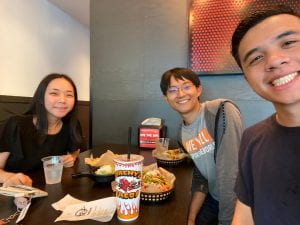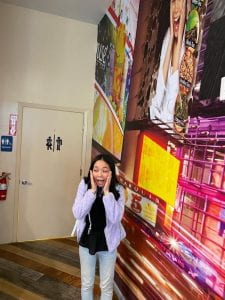My name is Gloria Ni, and I’m a freshman SEED intern majoring in Bioengineering with interests in engineering design, global health, computer science, and applied mathematics. I’m passionate about healthcare equity and user-centered, sustainable design. Welcome back to my blog!
This week, our team collaborated effectively to prototype an initial iteration of each joint in low-fidelity.
On Monday, we began with the knee, since it covers 2 out of 6 signs in the Ballard Assessment (Heel to Ear and Popliteal Angle). We brainstormed 3 solutions to integrate the angular resistance mechanism for the knee: modular protrusions, coiled string, and modular spring. First, we prototyped each mechanism in low-fidelity to explain and visualize our solutions (depicted below). Realizing the modular spring required an overly complex and unreliable implementation, we focused more on the coiled string and modular spring. These 2 solutions presented clear tradeoffs, but we ended up deciding on the coiled string mechanism because of greater precision and full range of angular resistance. Furthermore, we designed a CAD model that we 3D-printed for the hinge mechanism of the knee. Unfortunately, we encountered issues with the first print, quickly made adjustments to the model, and reprinted the design. The second iteration successfully came out; however, we decided adjustments could still be made to improve the range of motion.
On Tuesday, we tackled the elbow joint. For the elbow, we collectively decided on modular torsion spring mechanisms to display varying recoil angles. We began with prototyping the slot insert mechanisms in low-fidelity (depicted below). Next, we worked on a medium fidelity prototype by using CAD to design a limb with the slot insert. Upon testing the design, we quickly realized that it was not user-intuitive and adjusted the mechanism. However, the second design caused the device to wiggle instead of locking in place. Upon brainstorming further adjustments, we created a third iteration of the design.
On Wednesday, we continued with the shoulder and hip joint. For the hip, we used a metal ball-joint linkage to model the ball & socket motion of the biological joint. Since the OEDK already had a metal ball-joint linkage that we decided worked well for our model, we skipped the low-fi prototype of the hip joint and instead purchased a smaller ball-joint linkage to better fit our device. For the shoulder joint, we created a hinge joint with a wheel mechanism that fit into the structure of the doll we bought. After work, our team went to Torchy’s Tacos and Teahouse to celebrate our birthdays and bond together as a team. I’m extremely grateful to be able to learn more from my teammates each day, and especially to have the chance to take time outside of our project to have fun with and get to know each other outside of our work.
On Thursday, we worked on the wrist joint, in which we used the same coiled string mechanism as from the knee. Moreover, we looked into silicone molding and casting. I also attended an Arduino workshop, where we learned the basics of Arduino coding that built upon the soldering and circuitry skills we had learned before.
On Friday, we met with our client, Prince, and presented our design criteria and solution mechanisms. Following his emphasis on Ease of Use, we reprioritized our design objectives accordingly. Prince expressed positive feedback towards our knee, hip, and shoulder solutions; however, he communicated that the modular torsion spring solution for the elbow may allow for important parts to be easily broken and misplaced. Moreover, we created a silicone mold for the lower and upper leg, and we successfully casted the lower leg.
I would like to conclude again with a major thank you and acknowledgement to fellow NIMBS teammates, Lam Nguyen and Andrew Sun; our client, Prince Mtenthaonga; our Design Supervisors, Shannon McGill and Alois Chipfurutse; and SEED/Rice 360 staff, Imari Fletcher, Dr. Deirdre Hunter, and Dr. Ashley Taylor. I’m very grateful that they made my experience these past weeks possible and extremely look forward to the upcoming week of prototyping!


